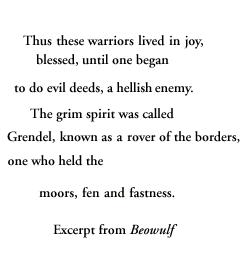The Anglo Saxons and the Jutes, of Germany bring among them their language, paganism and their district warrior traditions as they invades the Roman colony of Britain in the fifth and sixth century. The Anglo Saxons are fierce and adventurous people with the fondness of war and love for the blue sea. Their manliness, heroism and hard toil are exhibited in Anglo Saxon heroic poetry. Here we come across a generally elevated elevating, and male centered literature, one which lays stress on the virtues of a tribal community, on the ties of loyalty between lord and liegeman, on the significance of individual heroism, and on the powerful sway of ‘wyrd’ or fate.
Beowulf is an epic narrative celebrating the achievements of a hero. The poet narrator is anonymous and knows that his story is of a pagan type where the characters reflect pagan virtues and pre-Christian attitude to the outside world. The storyline of Beowulf in built around great fights with monsters who come in between the narrative by intruding themselves into accounts of human celebration and community. Hrothgar, the king of Danes, builds a wonderful court at Heorot where at every night there is feast and merry making. But there is a sinister and grotesque order of creatures bent on finishing off both king and court. Monster Grendel under the cover of the dark night intrudes into the court and kils the warriors. These things continues for long fifteen years. Then it is Beowulf the hero who accosts the abominable predator Grendel, challenges him, inflicts the fatal blow to the intruder and drives him back to his lair in the wilderness and kills him.
There is euphoria and jubilation over the triumph of Beowulf over Grendel, the malevolent monster. But soon Grendel’s mother wants to average her son’s death and mounts a new attack on Heorot. Beowulf chases her into her watery retreat along with his followers. Running through uninhabitable deserts, empty fons, and black sea cliff, he ultimately kills the she monster. After taming the unsafe, cold wild world of beasts, the inheritance of the out cast, the exile and the outsider, Beowulf gets honours and rewards in his homeland. He later becomes the king of Gates and rules for many years. In his old age, Beowulf once again wages a fight for great cause but his ‘wyrd’ (fate) plays a grand and tragic irony. Beowulf is betrayed by his own followers except one to whom ‘Death is better for Warrior than a woeful life shame’. Beowulf is fatally wounded and dies a death of an epical hero.
Beowulf is a saga of primitive race-their values, morals, loyalty, sacrifice, fearlessness, courtesy, tolerance and heroism. It is an experience of primitive people marching towards a civilized people.
We find the reflection of social and military fidelity in Beowulf in other old English literature. The Battle of Maldon or The Death of Byrthnoth is a terrific battle fought between the Essex nobleman Byrthnoth and a pirate party of Vikings. It is an older epic style and examine the stresses and strains innate in the heroic mode of action. Byrthnoth is great and brave but a rash warrior. He achieves martyrdom by losing his life and those of his vassals for the sake of his liege – lord king Ethelred and his nation.
The Fight at Fimsburg, a fragment of only fifty lines is a spirited account of fighting and brings out the fierce struggle and heroism in whom blood – lust is yet very strong.
In another poem Judith we have only the end of it, but that, giving in some 350 lines the slaughter of Holoferness by Judith and the Triumph of the Jews, is the most interesting part of the story.
The Anglo – Saxon heroic poems are vivid description of the battles and struggles, yet, they are allegorical in the inner interpretation to the fight between good and evil, between humanity and the destructive forces and the Wyrd or forces of nature. The imageries in these poems are full of artistry and poetic inspirations for the English poets of next generations.


Very nice blog...I found it very informative...I write poetry myself and would like for you to look at it and tell me what you think...Thanks...
ReplyDeleteSIR UR BLOG IS AWESOME .I'M STUDENT AND I FOLLOW UR WRITINGS , ITS VERY HELPFUL .THANKS :)
ReplyDeleteif anyone need any information about old english then this is the best blog among all those i have checked...i personally got lots of help
ReplyDeleteif anyone need any information about old english then this is the best blog among all those i have checked...i personally got lots of help
ReplyDeleteCan Judith be considered as Heroic poetry?as most of the writers ingnore this.
ReplyDelete